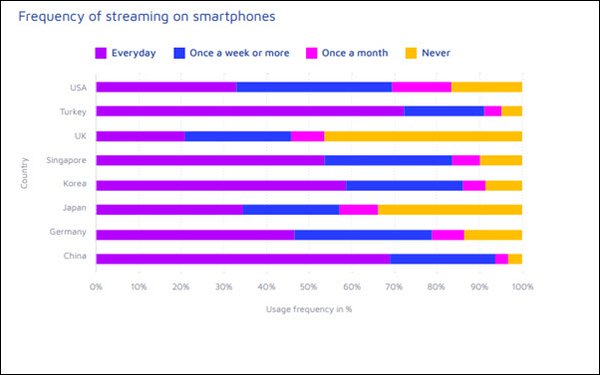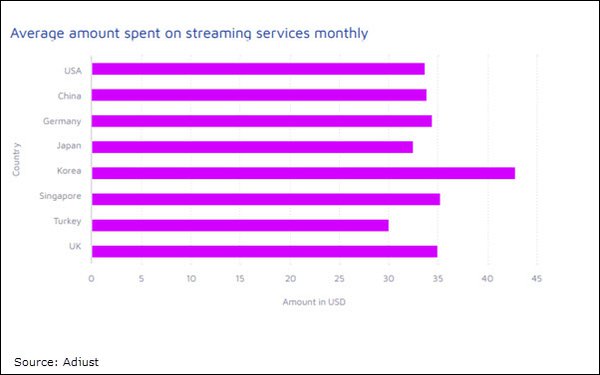Half Of Mobile Users Are Doing More Streaming Via Phone Since The Pandemic
- by Karlene Lukovitz @KLmarketdaily, February 17, 2021

Contrary to the common assumption that most mobile streaming takes place while commuting, a new study finds that 47% of U.S. mobile phone users are doing more streaming via mobile than before the pandemic and social distancing.
About 45% report doing about the same amount of streaming of video and TV content via mobile now, and just 7% say they’re doing this less.
The survey, conducted in November by global app marketing analytics platform Adjust, also found that on average, 52.5% of smartphone users across eight countries — the U.S., U.K., Germany, Turkey, Japan, Singapore, Korea, and China — report that they’re using their phones to stream more now than prior to the pandemic. Nearly a third (31.5%) report no change in this behavior.
The respondent pool was 8,000 consumers (1,000 per country) age 16 and up, with some questions open only to those who indicated that they use their smartphones to stream.
Across the regions, just 12% are streaming less, on average, while four times more are doing more mobile streaming.
Since the coronavirus outbreak, consumers are streaming significantly more globally, with U.S. and U.K. users reporting 46.9% and 32.4% increases, respectively.
Most users — including 69.4% in the U.S. — report using mobile to stream at least once a day.
Users in China (93.8%) and Turkey (91.9%) stream most frequently — every day to once a week — compared to 57.2% for Japan and 45.7% for the U.K.

Across the regions, 55% of Gen Z and 58% of Millennials stream content on their phones every day, and 30% and 28%, respectively, stream at least once a week or more. Just 9% and 8%, respectively, do
not stream via mobile.
Older generations are also streaming more.
Fully 58% of those 55 and older report streaming content at least once a week, and 35% of boomers use their phones to stream every day — although 32% still say they never use phones to stream.
Millennials, the biggest mobile streamers, are also watching for the longest periods of time. Their average session length averages just over 94 minutes, closely followed by Gen Z (87.6).
Users 55 and older aren’t all that far behind, at 65 minutes.
The research finds particularly strong streaming habits across generations in mobile-first countries.
Nearly 90% of users aged 55 and older in China (89.8%) and Turkey (88.9%) say they stream via their phone every day or at least more than once a week.
APAC — a region that has leapfrogged much of the world in mobile and internet use and penetration — is home to the biggest users of mobile to stream video and TV content. Turkey’s usage levels are twice as high as in the U.K. and nearly 25% higher than in the U.S.
U.S. consumers report spending $33.58 per month on average on streaming services — about the same as those in the U.K. ($34.82). Korean consumers spend the most, at $42.68.

Across countries, the average session time for watching
traditional (cable) TV is 95 minutes.
In the U.S., the TV session average is 108 minutes, compared to 78 minutes for cable.
The average session time gap between mobile and TV devices is narrower in mobile-first countries. In Turkey, for instance, the difference is less than 15%, compared to Singapore and Korea, where the difference hovers at 10%.

“This drastic shift to routine mobile streaming around the world and across generations has created massive advertising opportunities and a new role for mobile analytics,” said Gijsbert Pols, lead product strategist at Adjust, which is posting the full report on its site.


